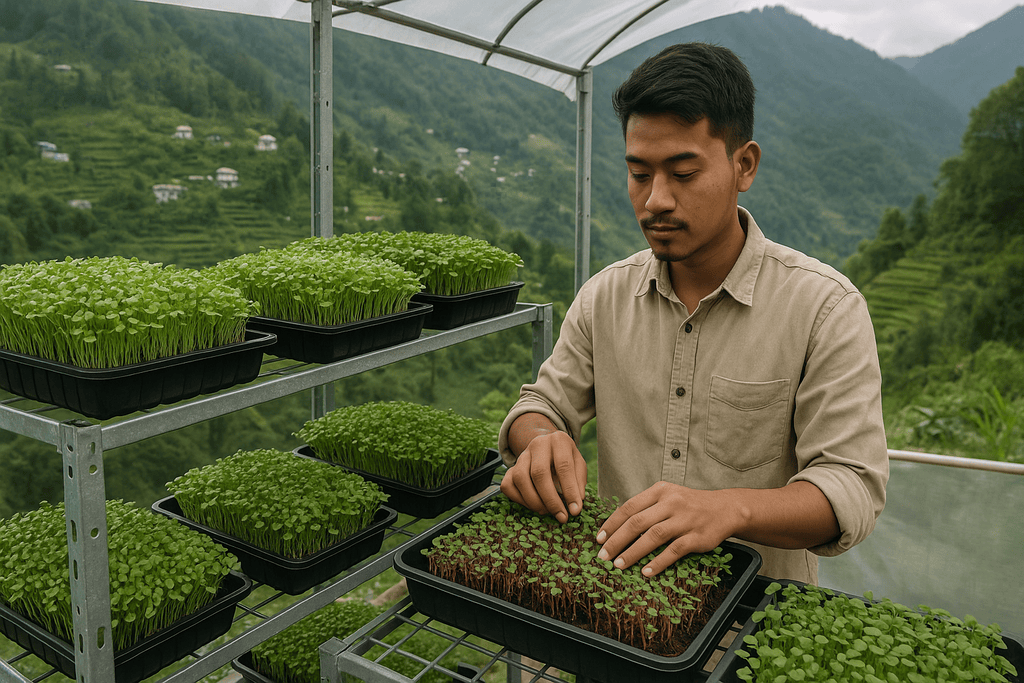In a conscious step to widen farming opportunities and respond to the changing agricultural landscape, the Sikkim agriculture department has initiated a program aimed at promoting the cultivation of microgreens across the state. This effort is rooted in the dual objective of encouraging sustainable farming in limited spaces and offering newer avenues of income for both traditional farmers and the younger population who are increasingly seeking alternatives in the agricultural sector.
Sikkim, known for its hilly terrain and commitment to organic farming, faces practical challenges when it comes to large-scale cultivation due to constraints of arable land, especially in urban regions like Gangtok. Recognizing this, the agriculture department has turned its attention to microgreens, small but nutrient-dense vegetable seedlings that require little space and time to grow. The initiative hopes to make microgreens cultivation a viable livelihood option, particularly suited to the state’s geographic and economic realities.
Cofam Joins Hands with the State
To ensure the project is grounded in technical know-how, the Sikkim agriculture department roped in the Centre of Floriculture and Agri-Business Management (Cofam), an institution under North Bengal University (NBU) in Siliguri. Cofam’s expertise in sustainable farming and urban agricultural models became central to shaping the first phase of the initiative.
In collaboration with Cofam, the state launched its training programme by focusing on capacity-building within the government’s own ranks. Around 150 officials from the agriculture department were trained by Cofam experts on how to cultivate microgreens through methods like terrace and vertical farming. These training sessions were not limited to theoretical concepts; they included practical demonstrations and hands-on learning tailored to Sikkim’s specific environmental context.
Amarendra Kumar Pandey, practical demonstrator at Cofam, shared insights on the rationale behind choosing terrace farming as a core model. “The concept of ‘grow your own greens’ will be actively promoted among residents and institutions, especially in the tourism and hospitality sectors that define much of Gangtok’s economy. We have trained around 150 officials of the agriculture department, and they will now train the farmers,” he said.
Cultivating Greens and Opportunity
The broader vision of the initiative is to empower farmers with an additional source of income while creating space for young individuals to explore agricultural entrepreneurship. Pandey explained that the concept of “grow your own greens” would be actively encouraged among both local residents and institutions. This includes sectors like tourism and hospitality, which play a major role in the region’s economy and could potentially become steady consumers of locally-grown microgreens.
Around 150 officials of the agriculture department have been trained, and they will now train the farmers, laying out the cascading model of training. He further added, “The idea of the Sikkim government is to offer farmers an additional income stream and provide local youths with startup opportunities in agriculture. In particular, the department finds good business potential in microgreens not just as raw product, but also through value-added processing and packaging ventures,”
Microgreens, sometimes called microleaves, are harvested at the seedling stage of vegetables like mustard, radish, broccoli, or beetroot. These tender greens have attracted attention not just for their concentrated nutritional value, but also for their culinary appeal, especially among restaurants and wellness-conscious consumers.
Also Read: How Robotics Is Reimagining Farming Across the Globe and in India
From Pilot Project to Scalable Model
The current efforts are still in the early stages, but the government and technical partners have mapped out a plan to expand the project in phases. The first phase, now completed, emphasized training and setup. The next phase aims to link farmers with potential markets and explore distribution models for both fresh produce and value-added microgreen products.
Microgreens can be grown even in small spaces like terraces. People in Sikkim often struggle with land availability, especially in Gangtok. This is an ideal solution as there is added advantage of integrating this farming model into a region where tourism is strong. Given the strong presence of tourism and hotels in this region, microgreens can serve as both a nutritional option and a business model.
Training the Trainers and Building on the Ground
Yogesh Sharma, joint director of the Sikkim agriculture department, elaborated on how the training was structured to ensure long-term benefits. Block Technology Managers (BTMs) and Assistant Technology Managers (ATMs) from the Agriculture Technology Management Agency (ATMA), a body under the department, were selected as the first group of trainees.
“They are now the master trainers and are involved in cascading the training to the grassroots. Farmers and youths who are unemployed will be trained so that they have the skill to grow microgreens as a start-up project,” Sharma explained. The cascading training method is expected to gradually build a skilled base of growers throughout the state, ensuring the knowledge spreads beyond departmental confines into actual farming communities.
Sowing Seeds for a New Kind of Growth: Infrastructure and Support
To further support this transition to space-efficient agriculture, the department is introducing polyhouses to aid vertical farming techniques. These structures provide controlled environments that allow for the year-round cultivation of microgreens, offering a layer of consistency and predictability that outdoor farming doesn’t always allow.
“This is a new alternative earning option for youths of the state,” Sharma said, reinforcing the administration’s intent to present microgreens not merely as a temporary or stopgap initiative, but as a potentially sustainable livelihood route.
This move by the Sikkim agriculture department, while modest in its early scale, carries significance in how small-scale farming practices can be adapted to local challenges and aspirations. With technical backing, government support, and a plan to connect production to market demand, microgreens could become more than just a kitchen garden hobby—they might soon represent a key part of the state’s evolving agricultural identity.


